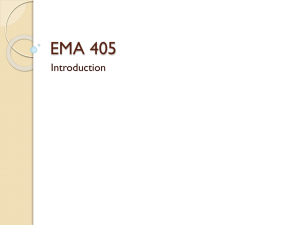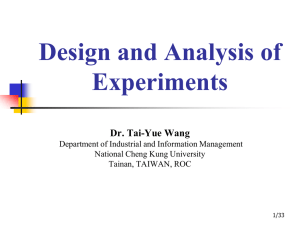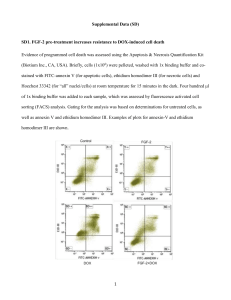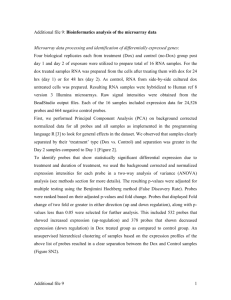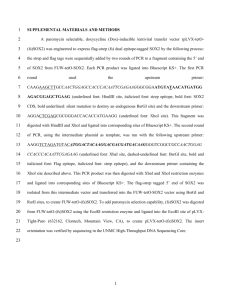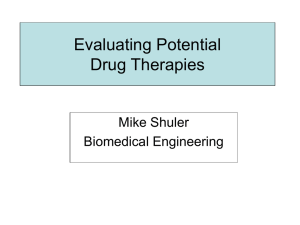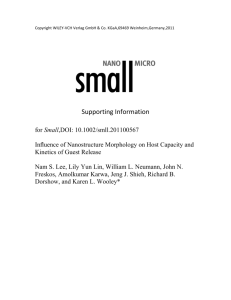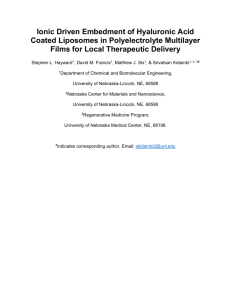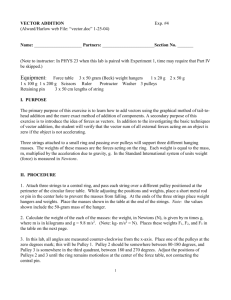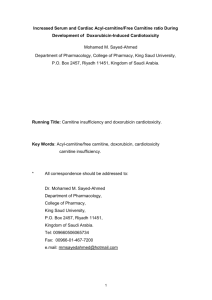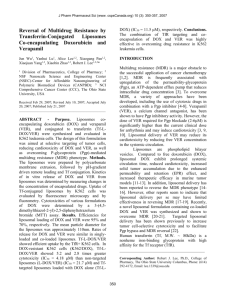Supplementary Information (doc 642K)
advertisement
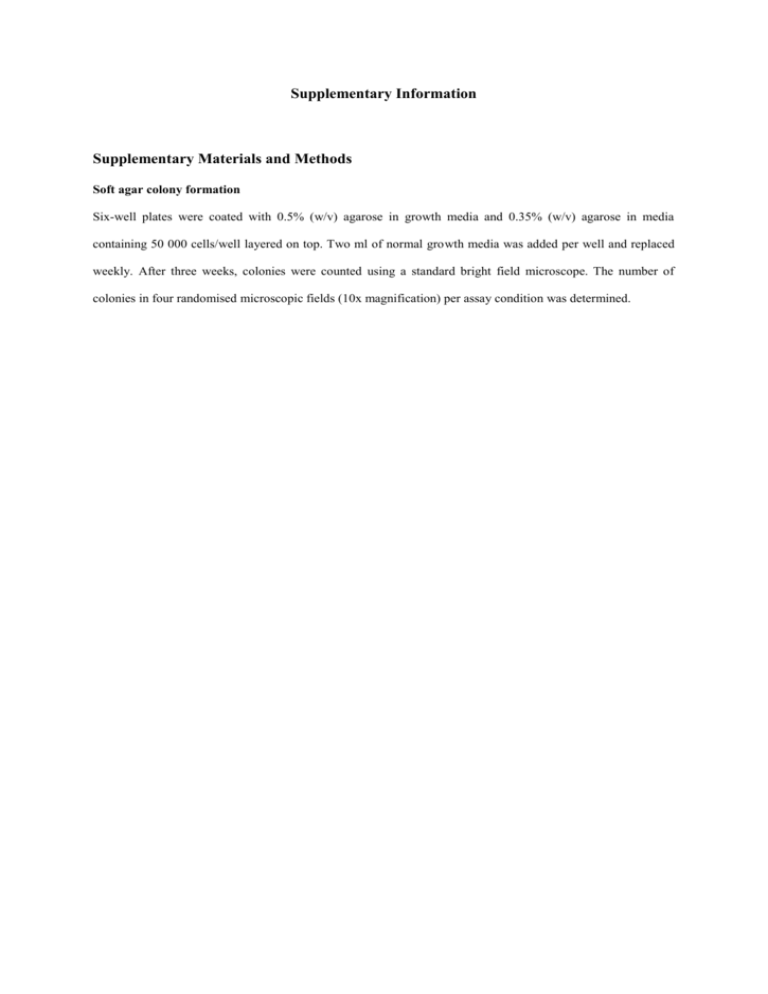
Supplementary Information Supplementary Materials and Methods Soft agar colony formation Six-well plates were coated with 0.5% (w/v) agarose in growth media and 0.35% (w/v) agarose in media containing 50 000 cells/well layered on top. Two ml of normal growth media was added per well and replaced weekly. After three weeks, colonies were counted using a standard bright field microscope. The number of colonies in four randomised microscopic fields (10x magnification) per assay condition was determined. Supplementary Figures r Draw area of interest around core and take note of area pixel number (A) Run positive pixel count algorithm, excluding A, and take note of pixel number (B) r Idealise core as circle with Area A. Calculate radius r. Calculate area of band around core with a thickness of r. This gives the 100% reference area. Supplementary Figure 1: Determination of spheroid invasiveness. Images were analysed using Aperio ImageScope software version 10 (Aperio Technologies, Vista, CA). An area of interest was drawn around the core spheroid structure and the number of pixels within this area determined. The invaded area was measured using a positive pixel count algorithm. Next, the core spheroid structure was idealised as a circle with radius r (calculated from the core spheroid area). A band with radius r was drawn around the idealised core spheroid structure and the total number of pixels in this band calculated (100% reference area). Finally, the invaded area pixel count was normalised to the 100% reference area. Cell Viability (MTT) WM793 2.5 2 Absorbance 2 1.5 1 KL - DOX KL + DOX KM - DOX KM + DOX 1.5 1 0.5 0.5 p=0.007 5 6 KM + DOX *** 1205Lu KL - DOX - *** 1205Lu *** KL - DOX - % Sub G1 KM + DOX KM - DOX 7 6 5 4 3 2 1 0 KL - DOX - # of Colonies Relative Signal KM + DOX KM - DOX KL + DOX KM + DOX KM - DOX KL + DOX KL - DOX 3.5 3 2.5 2 1.5 1 0.5 0 *** KL + DOX 8 7 6 5 4 3 2 1 0 200 180 160 140 120 100 80 60 40 20 0 *** Sub-G1 WM793 - % Sub-G1 D KL - DOX Caspase-Glo 3/7 WM793 KL - DOX 3.5 3 2.5 2 1.5 1 0.5 0 1205Lu ** - Relative Signal C 6 KM + DOX Colony Formation WM793 - # of Colonies 200 180 160 140 120 100 80 60 40 20 0 5 Days Days B 4 KM + DOX 4 3 KM - DOX 3 2 KM - DOX 2 1 KM - DOX 1 p=0.022 0 0 KL + DOX Absorbance 1205Lu KL + DOX 2.5 KL + DOX A Supplementary Figure 2: Functional characterisation of DOX-induced (+MSX2) vs. non-induced control cells (-MSX2) in two-dimensional cultures of WM793 and 1205Lu cells (sample results including all control cell lines). (a) Evaluation of cell viability over time using MTT assays. Significance was generated from the average signal change between consecutive days in three independent experiments. (b) Determination of clonogenic cell survival. (c) Assessment of caspase 3/7 activation using a bioluminescence-based Caspase-Glo 3/7 assay system. Luminescence readings were normalised to the total cell number and displayed relative to non-induced control cells. (d) Sub-G1 cell cycle population as detected via PI staining followed by flow cytometric analysis. Error bars represent the standard error of the mean within internal replicates. Significance levels were determined using an unpaired, two-tailed Student’s t-test. KL, cells infected with KRAB and LLCIEP (empty vector) encoding virus; KM, cells infected with KRAB and MSX2 encoding virus. p-Values refer to KM -/+ DOX results. Significance levels: * p<0.05, ** p<0.01, *** p<0.001. A + MSX2 Count Count WM793 - MSX2 Sub G1 1.1% PI (585 nm) Sub G1 4.7% PI (585 nm) B 15.2% 71.6% Count Count WM793 75.3% 7.2% PI (675 LP) 18% 6.7% PI (675 LP) Count Count 1205Lu C Sub G1 0.4% PI (585 nm) Sub G1 5.8% PI (585 nm) D 21.1% 12.2% PI (675 LP) 66.9% Count Count 1205Lu 64% 20.1% 10.4% PI (675 LP) Supplementary Figure 3: Cell cycle analysis in WM793 and 1205Lu cells in response to MSX2-overexpression. Representative histograms after PI staining and flow analysis of DOX-induced (+ MSX2) vs. noninduced control cells (- MSX2) including the Sub-G1 population of the cell cycle in (a) WM793 cells and (c) 1205Lu cells. Representative histograms after PI staining and flow analysis including viable cells only in (b) WM793 cells and (d) 1205Lu cells. A MSX2 β-actin B 14 ** % Sub G1 12 * 10 8 6 4 2 0 120 0 0.00010.0005 0.001 0.005 0.01 0.05 100 80 *** 60 40 *** *** 0.05 20 0.01 # of Colonies C 0 0.005 0.001 0.0005 0.0001 0 μg/ml Doxycycline Supplementary Figure 4: Dose-dependent effect of MSX2 expression in WM793 cells. (a) Western blot analysis of MSX2 protein levels in response to a gradient of DOX (as specified in panel (c)). β-Actin levels were used to assess total protein loading. Exposure time was adjusted to strongest signal to avoid over-exposure. (b) Cell cycle analysis by propidium iodide staining and flow cytometry-based evaluation. Values represent the percentage of cells in Sub-G1, an indicator for cellular apoptosis. (c) Soft agar colony formation assay to test for clonogenic survival/proliferation of cells in the absence of anchorage. Significance levels: * p<0.05, ** p<0.01, *** p<0.001. A All Subtypes B SSM and Nodular MSX2 positive (n=40) MSX2 negative (n=84) MSX2 negative (n=51) MSX2 positive (n=80) p = 0.918 C p = 0.351 All Subtypes D SSM and Nodular MSX2 positive (n=80) MSX2 positive (n=39) MSX2 negative (n=87) p = 0.990 MSX2 negative (n=52) p = 0.700 Supplementary Figure 5: Kaplan-Meier survival analysis of melanoma patients, stratified according to nuclear MSX2 expression. Recurrence-free survival of patients with (a) all melanoma subtypes and (b) SSM or nodular melanomas only. Overall survival of patients with (c) all melanoma subtypes and (d) SSM or nodular melanoma only. Supplementary Table Supplementary Table 1: Cox regression analysis of nuclear MSX2 expression and recurrence-free survival or overall survival (entire cohort). Prognostic Factor Recurrence Free Survival Nuclear MSX2 (pos. vs. neg., ref) T-Stage (T2-T4 vs. T1, ref) Ulceration (pos. vs. neg., ref) Overall Survival Nuclear MSX2 (pos. vs neg., ref) T-Stage (T2-T4 vs. T1, ref) Ulceration (pos. vs. neg., ref) 1 Multivariate1 (95% CI) p-value HR Univariate (95% CI) p-value HR 0.973 7.466 3.267 0.570-1.660 2.689-20.739 1.846-5.781 0.919 <0.001 <0.001 0.807 6.868 2.767 0.453-1.425 2.110-22.362 1.532-4.998 0.460 0.001 0.001 1.003 9.696 3.528 0.587-1.714 3.021-31.117 2.021-6.160 0.990 <0.001 <0.001 0.912 10.350 2.920 0.525-1.587 2.486-43.027 1.627-5.242 0.746 0.001 <0.001 Adjusted for all other variables in the subsection; ref, referent group; HR, hazard ratio; CI, confidence interval
